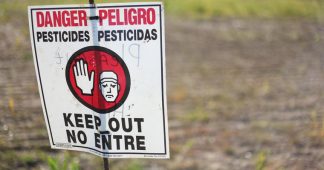By Francisco Sánchez-Bayo, Kris A.G.Wyckhuys
Jan.20, 2019
Abstract
Biodiversity of insects is threatened worldwide. Here, we present a comprehensive review of 73 historical reports of insect declines from across the globe, and systematically assess the underlying drivers. Our work reveals dramatic rates of decline that may lead to the extinction of 40% of the world’s insect species over the next few decades. In terrestrial ecosystems, Lepidoptera, Hymenoptera and dung beetles (Coleoptera) appear to be the taxa most affected, whereas four major aquatic taxa (Odonata, Plecoptera, Trichoptera and Ephemeroptera) have already lost a considerable proportion of species. Affected insect groups not only include specialists that occupy particular ecological niches, but also many common and generalist species. Concurrently, the abundance of a small number of species is increasing; these are all adaptable, generalist species that are occupying the vacant niches left by the ones declining. Among aquatic insects, habitat and dietary generalists, and pollutant-tolerant species are replacing the large biodiversity losses experienced in waters within agricultural and urban settings. The main drivers of species declines appear to be in order of importance: i) habitat loss and conversion to intensive agriculture and urbanisation; ii) pollution, mainly that by synthetic pesticides and fertilisers; iii) biological factors, including pathogens and introduced species; and iv) climate change. The latter factor is particularly important in tropical regions, but only affects a minority of species in colder climes and mountain settings of temperate zones. A rethinking of current agricultural practices, in particular a serious reduction in pesticide usage and its substitution with more sustainable, ecologically-based practices, is urgently needed to slow or reverse current trends, allow the recovery of declining insect populations and safeguard the vital ecosystem services they provide. In addition, effective remediation technologies should be applied to clean polluted waters in both agricultural and urban environments.
1. Introduction
For years, biologists and ecologists have been concerned about the worldwide reduction in biodiversity undergone by many terrestrial and aquatic vertebrates (Ceballos and Ehrlich, 2002; Pimm and Raven, 2000; Wilson, 2002), yet scientists have only recently voiced similar concerns about invertebrate taxa, particularly insects. Population declines imply not only less abundance but also a more restricted geographical distribution of species, and represent the first step towards extinction (Diamond, 1989). Much of the blame for biodiversity loss falls on human activities such as hunting and habitat loss through deforestation, agricultural expansion and intensification, industrialisation and urbanisation (Ceballos et al., 2017; Maxwell et al., 2016), which jointly claimed a 30–50% encroachment on natural ecosystems at the end of the 20th century (Vitousek et al., 1997).
There is compelling evidence that agricultural intensification is the main driver of population declines in unrelated taxa such as birds, insectivorous mammals and insects. In rural landscapes across the globe, the steady removal of natural habitat elements (e.g. hedgerows), elimination of natural drainage systems and other landscape features together with the recurrent use of chemical fertilisers and pesticides negatively affect overall biodiversity (Fuller et al., 1995; Newton, 2004; Tilman et al., 2001). Recent analyses point to the extensive usage of pesticides as primary factor responsible for the decline of birds in grasslands (Mineau and Whiteside, 2013) and aquatic organisms in streams (Beketov et al., 2013), with other factors contributing to or amplifying their effects to varying extent. Yet, we don’t know whether the same factors explain the parallel entomological demise that we are witnessing.
In 2017, a 27-year long population monitoring study revealed a shocking 76% decline in flying insect biomass at several of Germany’s protected areas (Hallmann et al., 2017). This represents an average 2.8% loss in insect biomass per year in habitats subject to rather low levels of human disturbance, which could either be undetectable or regarded statistically non-significant if measurements were carried out over shorter time frames. Worryingly, the study shows a steady declining trend over nearly three decades. A more recent study in rainforests of Puerto Rico has reported biomass losses between 98% and 78% for ground-foraging and canopy-dwelling arthropods over a 36-year period, with respective annual losses between 2.7% and 2.2% (Lister and Garcia, 2018). The latter authors showed parallel declines in birds, frogs and lizards at the same areas as a result of invertebrate food shortages. Both studies agree with the declining trend in flying insects (mainly Diptera) observed a decade earlier in parts of Southern Britain (Shortall et al., 2009). As insects comprise about two thirds of all terrestrial species on Earth, the above trends confirm that the sixth major extinction event is profoundly impacting life forms on our planet (Thomas et al., 2004).
While the arthropod declines in tropical rainforests correlate well with climatic changes, the 12 different factors (e.g. increases in arable land, deforestation, global warming) that were thought to be responsible for year-to-year drops in insect biomass in Germany barely accounted for ~20% of observed declines. Rather surprisingly, 80% of observed inter-annual variability in insect numbers was left unexplained (Hallmann et al., 2017). Although the authors did not assess the effect of synthetic pesticides, they did point to them as a likely driver of the pervasive losses in insect biomass.
The above studies, however, are in line with previous reports on population declines among numerous insect taxa (i.e. butterflies, ground beetles, ladybirds, dragonflies, stoneflies and wild bees) in Europe and North America over the past decades. It appears that insect declines are substantially greater than those observed in birds or plants over the same time periods (Thomas et al., 2004), and this could trigger wide-ranging cascading effects within several of the world’s ecosystems.
This review summarises our current state of knowledge about insect declines, i.e., the changes in species richness (biodiversity) and population abundance through time, and points to the likely drivers of the losses so that conservation strategies to mitigate or even reverse them may be implemented. Previous reviews are partial in scope, restricted to individual groups of insects (e.g. butterflies, carabids) in specific regions, but no study has put together a comprehensive review of all insect taxa nor compared the local findings among different parts of the world.
Read more at https://www.sciencedirect.com/science/article/pii/S0006320718313636











